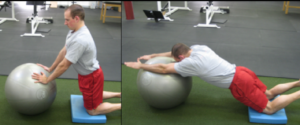
5 “Combo” Core Stability Exercises
Core stability exercises are kind of like visits to the dentist. You know you need to do them – and they keep you healthy – but they aren’t really all that sexy and enjoyable. With this in mind, I think the concept of “minimum effective dose” is an especially important consideration when it comes to programming core stability exercises. We want to pick the drills that give the biggest bang for one’s buck: a great training effect in only a few sets.
Fortunately, if we understand how to classify core stability exercises, we can quick recognize that there are ways to deliver more efficient training prescriptions. Speaking broadly, you have four core stability exercise categories: anterior core stability, posterior core stability, lateral core stability, and rotary core stability.
Anterior core stability exercises teach the body to resist excessive lumbar spine extension (arching), and encompass a variety of drills, starting with the likes of curl-ups, prone bridges/planks, and reverse crunches. In prepared individuals, they progress all the way up through more advanced exercises like stability ball rollouts, and TRX flutters and fallouts.

Posterior core stability exercises train the body to resist excessive lumbar spine flexion (rounding). These drills include everything from the birddog all the way up through more conventional strength training exercises like deadlift variations.
Lateral core stability exercises teach you how to resist lateral flexion; in other words, your goal is to avoid tipping over. These drills may start with basic side bridging drills and progress all the way up through more advanced TRX drills and 1-arm carrying variations.
Rotary core stability exercises teach you to resist excessive rotation through the lumbar spine. Examples include drills like landmines, lifts, and chops.
Once you appreciate what each of these core stability exercise categories entail in terms of functional demands, you realize that you can combine these drills into options that train 2-3 at a time. Here are a few examples:
1. Reverse Crunch to Dead Bug – A reverse crunch would be considered anterior core drills, but in adding the dead bug component, you get an increased challenge to rotary stability because of the alternating leg/arm component. Of course, the dead bug is already a solid “combination” core stability exercise by itself.
2. 1-leg TRX Fallouts – As I noted early, fallouts are a great anterior core training progression. Going to a single-leg stance makes this an awesome rotary stability and lateral core challenge, too.
3. Tall Kneeling Cable Press to Overhead Lift – Asymmetrical presses are usually only a big challenge to rotary and lateral core stability, but adding the overhead reach component kicks up the anterior core challenge.
4. Lateral Lunge with Band Overhead Reach – This one gets some extra bonus points because it’s an excellent hip mobility challenge, too. It takes a lateral and rotary core stability drill and incorporates more anterior core because of the overhead reach. It’s a game-changer when an athlete can own the frontal plane with sagittal plane control, too.
5. Dumbbell Suitcase Deadlift – You won’t find a better posterior core stability exercise than a properly performed deadlift. You won’t be able to load it as much in the suitcase set-up, but you’ll definitely increase the challenge to lateral core stability.
These are just five of countless variations you can create to cover a few core stability exercise categories with one drill. I’ve found them to be particularly useful with in-season programs, when athletes have limited time to train.




